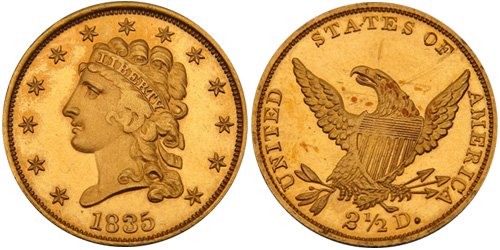Classic Head Quarter Eagle
Source: My Coin Guides: Short-lived but important for various reasons, the Classic Head Quarter Eagle was struck from 1834 to 1839. This was the first series for the $2.50 gold denomination to meaningfully circulate, and for the initial years the mintages were fairly large. In the final years of the series, mintages would decline making these issues scarce to rare. The year 1838 would represent the first time that a mint mark appeared on the denomination when quarter eagles were struck at the new branch mint in Charlotte. This was followed by production at Dahlonega and New Orleans in 1939, after which the design for the denomination was changed, ending the production of this important series struck at a turning point in the production of American gold coinage.

In the early 20th century, the production of quarter eagles had been extremely sparse, and pieces were virtually unseen in circulation. The value of the denomination was too high for domestic use within commerce and too low for exportation purposes, leading to limited demand. Additionally, at various times the value of the gold exceeded the $2.50 value of the quarter eagle, leading quantities to be melted soon after their mintage. The situation would change after the passage of the Coinage Act of 1834, which was signed into law on June 27 and became effective on August 1, 1834. The Act respecified the value of gold in relation to the dollar by reducing the gold content of each denomination. The weight of the quarter eagle was specified at 64.5 grains, with 58 grains of pure gold content.
The new design for the quarter eagle to be struck with these specifications was designed by William Kneass. He was an engraver who had been employed at the Mint in various positions since 1805 and had previously modified the quarter eagle design in 1829. His new design still showed some resemblance to the previous type, but the overall appearance was much different.
The obverse of the Classic Head Quarter Eagle featured the head of Liberty, facing left. She has a much younger appearance than the previous type, with her hair in easily noticeable curls bound by a ribbon bearing the word LIBERTY. The image is surrounded by thirteen stars with the date placed below. The reverse design features an eagle with wings spread, a shield at its chest, and an olive branch and three arrows in its talons. The words UNITED STATES OF AMERICA appears around, with the denomination expressed as 2 ½ D. below. This reverse was a modified form of the previous type, but with smaller details and a plain field above the eagle’s head, rather than the previous scroll with motto.
After two years of producing more than 100,000 quarter eagles, production jumped to more than half a million in 1836. The following year, the Mint Act of 1837 would bring a change for the series, by altering the alloy in gold coins slightly, mandating a purity of 90% rather than the previous 89.92%. After the change, the quarter eagles struck in 1837, 1838 and 1839 at the Philadelphia Mints would have much lower mintages. These are scarcer than the earlier dates, but only slightly more expensive, making them good candidates for an advanced type collection. In addition to business strikes, the Philadelphia Mint produced small numbers of proof coins for each year the series was minted. These are all extremely rare and are seldom available.
In 1838 and 1839, production of the Classic Head Quarter Eagle also took place at recently or newly established branch mints. Located in gold rush areas, Charlotte and Dahlonega served the need for production of gold coins, while the New Orleans Mint, struck both gold and silver coinage. In 1838, only the Charlotte Mint produced quarter eagles with only 7,880 struck, representing the lowest mintage for the series. In 1839, both Dahlonega and New Orleans produced quarter eagles for the first time. While not as rare as the 1838-C, the branch mint issues are all scarcer than the Philadelphia issues. All the branch mint issues circulated extensively, making them the most difficult to acquire in uncirculated condition for this type.
